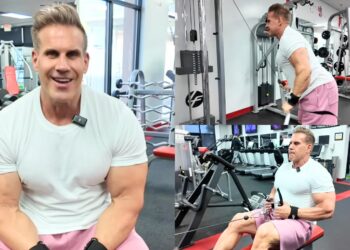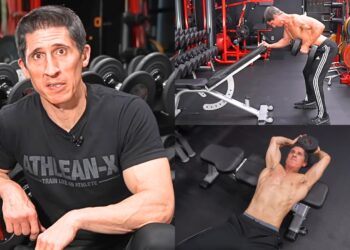The lat pulldown is probably the most popular back exercise. This makes perfect sense, given how effectively it hits the lats and mid-back. Whether you want mass, shape, or strength, lat pulldowns can help you build the V-shaped back of your dreams.
In addition, lat pulldowns are relatively easy to learn. This makes them ideal for all levels of experience, from raw beginners to the most advanced lifters. They’re also a very safe exercise, with very little risk of injury.
So, long story short, lat pulldowns are a fantastic exercise, which is why they feature in so many back workouts.
Of course, to do lat pulldowns, you need a lat pulldown machine. That’s no problem if you train in a well-equipped gym. However, this could be an issue if you work out at home. After all, lat pulldown machines are tall, heavy, and expensive, making them impractical for most home exercisers.
As a 30-year veteran personal trainer, I work with clients in a range of venues. Sometimes I have access to fully equipped gyms, but at other times I have to make do with just bodyweight exercises.
Not having access to a well-equipped gym can often seem like a massive disadvantage. But, in my experience, there are still lots of exercises you can do that will build, shape, and strengthen your back.
Level Up Your Fitness: Join our 💪 strong community in Fitness Volt Newsletter. Get daily inspiration, expert-backed workouts, nutrition tips, the latest in strength sports, and the support you need to reach your goals. Subscribe for free!
In this article, I share six of my favorite bodyweight lat pulldown alternatives, and a workout designed to help you build the V-taper you’ve always wanted.
The 6 Best Bodyweight Lat Pulldown Alternatives
No lat pulldown? Don’t worry – you can still build a great-looking back. Here are six incredible body weight back exercises, all tried and tested just for you!
1. Pull-Up
As a former British Royal Marine commando, I’ve done thousands of pull-ups as they were an integral part of my combat fitness training. Pull-ups build back strength better than almost any other exercise. While they look very different, pull-ups and pulldowns involve a very similar movement pattern and are pretty much interchangeable.
Steps:
- Hang from an overhead bar with an overhand, slightly wider than shoulder-width grip. Brace your core and pull your shoulders back and down. Bend your legs and lift your feet off the floor.
- Bend your arms and pull your chin up and over the bar.
- Descend smoothly and repeat.
Tips:
- Drive your elbows down and back to maximize muscle engagement.
- Avoid kicking or swinging your legs as this takes work away from the target muscles.
- Add a weighted vest to make this exercise harder, or a resistance band to offset some of your body weight and make it easier:
2. Chin-Up
Chin-ups and pull-ups are very similar, and both can help you build an impressive back and V-taper. However, because of the difference in hand placement, some people prefer one exercise over the other. Studies tell us that both exercises target the same muscles (1), so do the one you find the most comfortable and effective.
Steps:
- Hang from an overhead bar with an underhand, slightly narrower than shoulder-width grip. Brace your core and pull your shoulders back and down. Bend your legs and lift your feet off the floor.
- Bend your arms and pull your chin up and over the bar.
- Descend smoothly and repeat.
Tips:
- Use gym chalk or lifting straps to reinforce your grip if necessary.
- Pause for 2-3 seconds at the top of each rep to increase back muscle engagement.
- Step or jump up and lower yourself down slowly if you are unable to do chin-ups unaided:
Related: Pull-Ups Vs. Chin-Ups – Which One is Right for You?
3. Commando Pull-Up
Despite having been a commando, I only learned about this exercise after leaving the Royal Marines, so I don’t know how they got their name. Regardless of this, the commando pull-up is a fabulous back builder that’s easy on your elbows and shoulders, and that many people prefer to conventional pull-ups and chin-ups. Try ’em – I think you’ll like ’em!
Steps:
- Stand sideways beneath your pull-up bar, gripping it so both hands face inward. The thumb of one hand should be touching the little finger of the other.
- Hang with your feet clear of the floor, arms straight, and core braced. Pull your shoulders down and back.
- Bend your arms and pull yourself up so your head travels out to one side of the bar. Touch the bar with your shoulder.
- Slowly extend your arms and repeat. However, this time go to the other side of the bar.
- Alternate sides rep by rep and, for your next set, switch your hands around too.
Tips:
- Hang for a couple of seconds between reps to eliminate momentum and make this exercise even more effective.
- Squeeze your hands toward the midline of your body to prevent your legs from twisting.
- Use a resistance band to make this exercise easier or a weighted vest to make it more demanding.
4. Inverted Row
While pull-ups and chin-ups are the most obvious alternatives to lat pulldowns, they aren’t the only bodyweight back exercises. Inverted rows target your lats and mid-upper back and involve lifting less weight. As such they’re an excellent exercise for later in your program when your muscles are feeling tired. They’re also a great choice for beginners.
Steps:
- Set a bar/handle to around waist height, e.g., a barbell in a squat rack. Sit below the bar and hold it with an overhand, slightly wider than shoulder-width grip.
- Pull your shoulders down and back and brace your core.
- Lean back so your arms are straight. Extend your legs and lift your butt off the floor.
- Bend your arms and pull your chest up to the bar.
- Smoothly extend your arms and repeat.
Tips:
- Keep your core, glutes, and legs tight throughout your set.
- Raise the bar to take weight off your arms and make this exercise easier.
- You can also do this exercise with a suspension trainer, e.g., a TRX or similar, or gymnastic rings.
5. Tucked Front Lever Raise
The tucked front lever is a tough upper-back exercise. The movement is much like doing barbell, dumbbell, or machine pullovers, but using your body weight for resistance. As well as working your lats, you’ll feel this exercise in your core and triceps. Don’t worry if you find this exercise challenging – it’s meant to be!
Level Up Your Fitness: Join our 💪 strong community in Fitness Volt Newsletter. Get daily inspiration, expert-backed workouts, nutrition tips, the latest in strength sports, and the support you need to reach your goals. Subscribe for free!
Steps:
- Hang from a bar with a shoulder-width overhand grip.
- Brace your core and pull your shoulders down and back.
- Bend your legs and pull your knees to your chest. Lift your hips and lean back, simultaneously pushing forward and down with your arms.
- Raise your body until it’s roughly parallel to the floor.
- Descend under control and repeat.
Tips:
- Put a resistance band around your feet to make tucked front lever raises easier.
- You can also do this exercise as an isometric or static hold.
- Extend your legs to make this exercise harder – the full front lever:
6. Isometric Seated Towel Row
While the preceding bodyweight exercises are very effective, you need to be reasonably strong to perform them correctly. In contrast, the final exercise is only as hard as you make it, so it’s ideal for beginners and putting near the end of your workout, when your muscles are too tired for any more pull-ups and chin-ups.
Steps:
- Sit on the floor with your legs extended.
- Loop a towel over your feet and hold the ends so your arms are bent to about 90 degrees.
- Sit up tall, pull your shoulders back and down, and brace your core.
- Pull as hard as you can against the towel.
- Continue pulling for the prescribed duration.
Tips:
- Keep your upper arms close to your sides to maximize back muscle engagement.
- Do not hold your breath as doing so may increase in your blood pressure and leave you feeling faint or dizzy.
- You can also do this exercise standing, i.e., an isometric bent-over towel row:
Bodyweight Workout For a V-Shape Taper
While all these exercises work your lats, they’ll be more effective if you incorporate them into a program. You can write your own workouts but, to save you the bother, I’ve created one for you. Do this program 1-2 times a week to build the back of your dreams without lat pulldowns.
Of course, before you do even your first rep, make sure you spend a moment getting your body ready to train. Warming up will make your workout safer and more effective, so never skip this crucial step.
Begin your warm-up with 5-10 minutes of easy cardio followed by a few dynamic mobility and flexibility exercises for your elbows, shoulders, and lower back.
Warmed up and ready to work? Then let’s get to work!
| # | Exercise | Sets | Reps | Recovery |
| 1 | Pull-up | 3-4 | AMRAP | 90 seconds |
| 2 | Chin-up | 3-4 | AMRAP | 90 seconds |
| 3 | Tuck front lever raise | 3-4 | 4-6 | 90 seconds |
| 4 | Inverted row | 2-3 | AMRAP | 60 seconds |
| 5 | Isometric seated towel row | 2-3 | 20-30 sec. | 60 seconds |
*AMRAP= As Many Reps as Possible. Continue doing reps until you are within 1-3 reps of failure.
Frequently Asked Questions
Do you have a question about this workout? That’s okay because I’ve got the answers. Alternatively, if you need more information, drop me a line in the comments section below and I’ll get back to you ASAP.
1. Can you really build muscle with bodyweight exercises?
You certainly can! Ultimately, your muscles cannot differentiate between lat pulldowns on a state-of-the-art machine and doing pull-ups from a tree branch. Providing you train hard and often enough, your muscles will respond regardless of the equipment you use.
Not convinced? Check out the huge backs sported by gymnasts, most of whom do nothing but bodyweight exercises.
2. Are bodyweight back exercises safe?
With no weights to drop, bodyweight back exercises are pretty safe. However, you still cannot be complacent, as there is an injury risk with all types of strength training, including pull-ups, inverted rows, etc.
That said, you can reduce your chances of injury by:
- Always warming up properly
- Paying attention to your form
- Getting adequate rest between workouts
- Avoiding exercises that cause discomfort
3. What is the best diet for building muscle?
There is no one-size-fits-all diet for muscle growth. Rather, there are principles you must follow to ensure your muscles get the nutrients they need to grow. For example, you need a caloric surplus and adequate protein. Check out this article to discover how to eat for muscle growth.
Conclusion
Not having access to facilities is a common barrier to consistent exercise (2). That’s because many people believe they need special equipment to get fit, build muscle, and be healthy.
This is not true!
In fact, as little as 100 years ago, much of the equipment found in modern gyms didn’t exist. But, despite this, the exercisers of the day still managed to get in great shape.
So, don’t let a lack of equipment stand in your way. Achieve your fitness goals with bodyweight exercises, like these proven alternatives to lat pulldowns. Combined with plenty of push-ups, you can sculpt the upper body of your dreams, even if you work out at home.
Next read:
- How to Build a V-Taper – Training Guide and Nutrition Tips
- Calisthenics Back Workout for Size and Strength
References:
- Youdas JW, Amundson CL, Cicero KS, Hahn JJ, Harezlak DT, Hollman JH. Surface electromyographic activation patterns and elbow joint motion during a pull-up, chin-up, or perfect-pullup™ rotational exercise. J Strength Cond Res. 2010 Dec;24(12):3404-14. doi: 10.1519/JSC.0b013e3181f1598c. PMID: 21068680.
- Pedersen MRL, Hansen AF, Elmose-Østerlund K. Motives and Barriers Related to Physical Activity and Sport across Social Backgrounds: Implications for Health Promotion. Int J Environ Res Public Health. 2021 May 28;18(11):5810. doi: 10.3390/ijerph18115810. PMID: 34071630; PMCID: PMC8198157.









